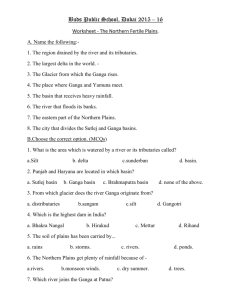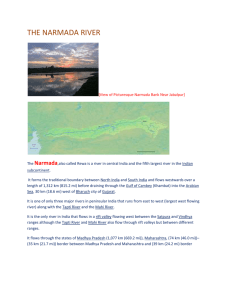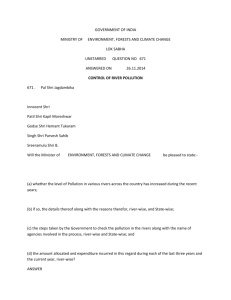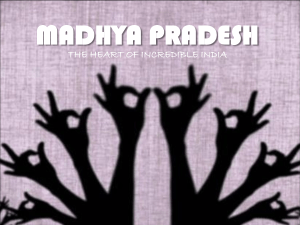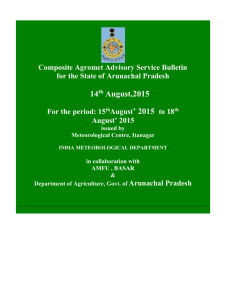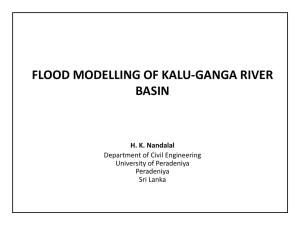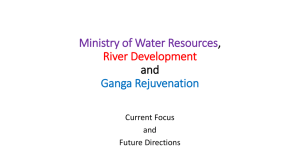Yamuna River System
advertisement
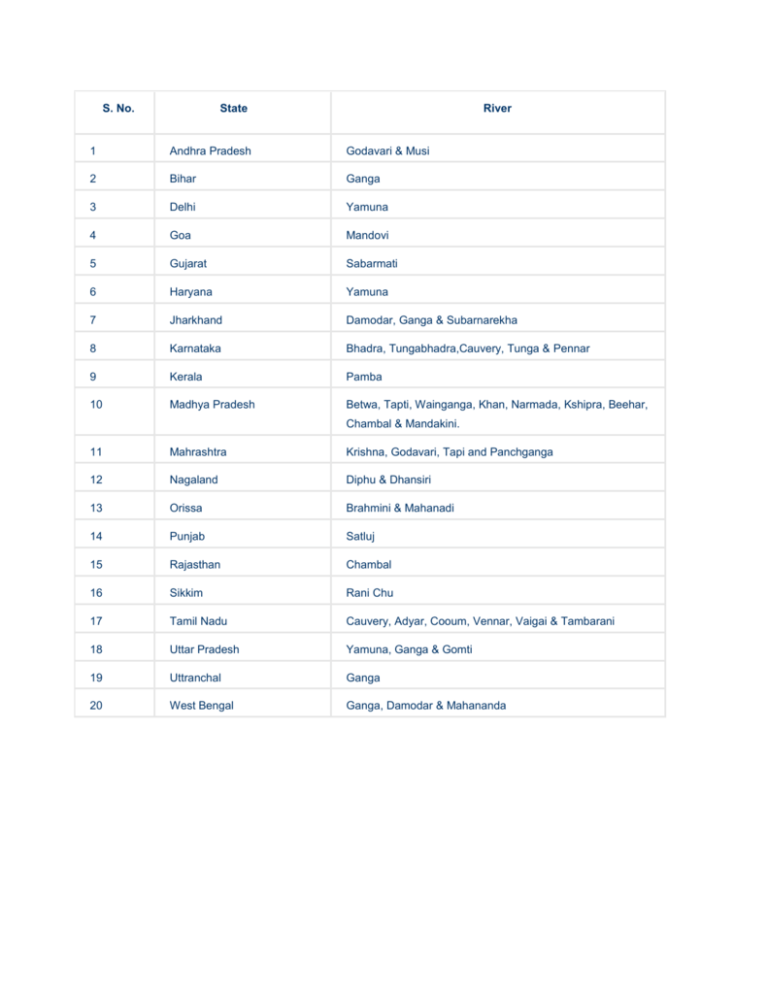
S. No. State River 1 Andhra Pradesh Godavari & Musi 2 Bihar Ganga 3 Delhi Yamuna 4 Goa Mandovi 5 Gujarat Sabarmati 6 Haryana Yamuna 7 Jharkhand Damodar, Ganga & Subarnarekha 8 Karnataka Bhadra, Tungabhadra,Cauvery, Tunga & Pennar 9 Kerala Pamba 10 Madhya Pradesh Betwa, Tapti, Wainganga, Khan, Narmada, Kshipra, Beehar, Chambal & Mandakini. 11 Mahrashtra Krishna, Godavari, Tapi and Panchganga 12 Nagaland Diphu & Dhansiri 13 Orissa Brahmini & Mahanadi 14 Punjab Satluj 15 Rajasthan Chambal 16 Sikkim Rani Chu 17 Tamil Nadu Cauvery, Adyar, Cooum, Vennar, Vaigai & Tambarani 18 Uttar Pradesh Yamuna, Ganga & Gomti 19 Uttranchal Ganga 20 West Bengal Ganga, Damodar & Mahananda Major River System in India « Go Back Contents [hide] 1 Indus River System 2 Brahmaputra River System 3 Ganga River System 4 Yamuna River System 5 Narmada River System 6 Tapti River System 7 Godavari River System 8 Krishna River System 9 Cauveri River System 10 Mahanadi River System Indus River System The Indus originates in the northern slopes of the Kailash range in Tibet near Lake Manasarovar. It follows a northwesterly course through Tibet. It enters Indian territory in Jammu and Kashmir. It forms a picturesque gorge in this part. Several tributaries - the Zaskar, the Shyok, the Nubra and the Hunza join it in the Kashmir region. It flows through the regions of Ladakh, Baltistan and Gilgit and runs between the Ladakh Range and the Zaskar Range. It crosses the Himalayas through a 5181 m deep gorge near Attock, lying north of the Nanga Parbat and later takes a bend to the south west direction before entering Pakistan. It has a large number of tributaries in both India and Pakistan and has a total length of about 2897 km from the source to the point near Karachi where it falls into the Arabian Sea. The main tributaries of the Indus in India are Jhelum, Chenab, Ravi, Beas and Sutlej. Brahmaputra River System The Brahmaputra originates in the Mansarovar lake, also the source of the Indus and the Satluj. It is slightly longer than the Indus, but most of its course lies outside India. It flows eastward, parallel to the Himalayas. Reaching Namcha Barwa (7757 m), it takes a U-turn around it and enters India in Arunachal Pradesh and known as dihang. The undercutting done by this river is of the order of 5500 metres. In India, it flows through Arunachal Pradesh and Assam, and is joined by several tributaries. Ganga River System The Ganga (Ganges) rises from the Gangotri Glacier in the Garhwal Himalayas at an elevation of some 4100 metres above the sea level under the name of Bhagirathi. This main stream of the river flows through the Himalayas till another two streams – the Mandakini and the Alaknanda – join it at Dev Prayag, the point of confluence. The combined stream is then known as the Ganga. The main tributaries of the Ganga are Yamuna, Ram Ganga, Gomati, Ghaghara, Son, Damodar and Sapt Kosi. The river after traversing a distance of 2525 kms from its source meets the Bay of Bengal at Ganga Sagar in West Bengal. Yamuna River System The River Yamuna originates from the Yamunotri glacier, 6387m above mean sea level (msl), at the Banderpoonch peak in the Uttarkashi district of Uttarakhand. The catchment of the river extends to states of Uttar Pradesh,Himachal Pradesh, Haryana, Rajasthan and Madhya Pradesh and the entire union territory of Delhi. The river flows 1367 km from here to its confluence with the River Ganga at Allahabad. The main tributaries joining the river include the Hindon, Chambal, Sind, Betwa and Ken. The annual flow of the river is about 10,000 cumecs. The annual usage is 4400 cumecs, irrigation accounting for 96% of this. Narmada River System The Narmada or Nerbudda is a river in central India. It forms the traditional boundary between North India and South India, and is a total of 1,289 km (801 mi) long. Of the major rivers of peninsular India, only the Narmada, the Tapti and the Mahi run from east to west. It rises on the summit of Amarkantak Hill in Madhya Pradesh state, and for the first 320 kilometres (200 miles) of its course winds among the Mandla Hills, which form the head of the Satpura Range; then at Jabalpur, passing through the 'Marble Rocks', it enters the Narmada Valley between the Vindhya and Satpura ranges, and pursues a direct westerly course to the Gulf of Cambay. Its total length through the states of Madhya Pradesh, Maharashtra, and Gujarat amounts to 1312 kilometres (815 miles), and it empties into the Arabian Sea in the Bharuch district of Gujarat. Tapti River System The Tapi is a river of central India. It is one of the major rivers of peninsular India with the length of around 724 km; it runs from east to west. It rises in the eastern Satpura Range of southern Madhya Pradesh state, and flows westward, draining Madhya Pradesh's historic Nimar region, Maharashtra's historic Khandesh and east Vidarbha re-gions in the northwest corner of the Deccan Plateau and South Gujarat before emptying into the Gulf of Cambay of the Arabian Sea, in the State of Gujarat. The Western Ghats or Sahyadri range starts south of the Tapti River near the border of Gujarat and Maharashtra. The Tapi River Basin lies mostly in northern and eastern districts Maharashtra state viz, Amravati, Akola, Buldhana, Washim, Jalgaon, Dhule, Nandurbar, Malegaon, Nashik districts but also covers Betul, Burhanpur districts of Madhya Pradesh and Surat district in Gujarat as well. The principal tributaries of Tapi River are Purna River, Girna River, Panzara River, Waghur River, Bori River and Aner River.</p> Godavari River System The river with second longest course within India, Godavari is often referred to as the Vriddh (Old) Ganga or the Dakshin (South) Ganga. The name may be apt in more ways than one, as the river follows the course of Ganga's tragedy. The river is about 1,450 km (900 miles) long. It rises at Trimbakeshwar, near Nasik and Mumbai (formerly Bombay) in Maharashtra around 380 km distance from the Arabian Sea, but flows southeast across south-central India through the states of Madhya Pradesh, Karnataka, Orissa and Andhra Pradesh, and empties into the Bay of Bengal. At Rajahmundry, 80 km from the coast, the river splits into two streams thus forming a very fertile delta. Some of its tributaries include Indravati River, Manjira, Bindusara and Sabari. Some important urban centers on its banks include Nasik, Bhadrachalam, Rajahmundry and Narsapur. The Asia's largest rail-cum-road bridge on the river Godavari linking Kovvur and Rajahmundry is considered to be an engineering feat. Krishna River System The Krishna is one of the longest rivers of India (about 1300 km in length). It originates at Mahabaleswar in Maharashtra, passes through Sangli and meets the sea in the Bay of Bengal at Hamasaladeevi in Andhra Pradesh. The Krishna River flows through the states of Maharashtra, Karnataka and Andhra Pradesh. The traditional source of the river is a spout from the mouth of a statue of a cow in the ancient temple of Mahadev in Mahabaleshwar. Its most important tributary is the Tungabhadra River, which itself is formed by the Tunga and Bhadra rivers that originate in the Western Ghats. Other tributaries include the Koyna, Bhima, Mallaprabha, Ghataprabha, Yerla, Warna, Dindi, Musi and Dudhganga rivers. Cauveri River System The Cauveri (also spelled Kavery) is one of the great rivers of India and is considered sacred by the Hindus. This river is also called Dakshin Ganga. The headwaters are in the Western Ghats range of Karnataka state, and flows from Karnataka through Tamil Nadu. It empties into the Bay of Bengal. Its waters have supported irrigated agriculture for centuries, and the Cauveri has been the lifeblood of the ancient kingdoms and modern cities of South India. The source of the river is Talakaveri located in the Western Ghats about 5,000 feet (1,500 m) above sea level. It flows generally south and east for around 765 km, emptying into the Bay of Bengal through two principal mouths. Its basin is estimated to be 27,700 square miles (71,700 km²), and it has many tributaries including Shimsha, Hemavati, Arkavathy, Kapila, Honnuhole, Lakshmana Tirtha, Kabini, Lokapavani, Bhavani, Noyyal and Famous Amaravati. Mahanadi River System The Mahanadi River system is the third largest in the peninsula of India and the largest river of Orissa state. The basin (80º30’–86º50’ E and 19º20’–23º35’ N) extends over an area approximately 141,600 km2, has a total length of 851 km and an annual runoff of 50X109 m3 with a peak discharge of 44740 m3 s-1. The basin is characterized by a tropical climate with average annual rainfall of 142 cm (NWDA, 1981) with 90% occurring during the SW-monsoon. The river begins in the Baster hills of Madhya Pradesh flows over different geological formations of Eastern Ghats and adjacent areas and joins the Bay of Bengal after divided into different branches in the deltaic area. The main branches of River Mahanadi meet Bay of Bengal at Paradip and Nuagarh (Devi estuary). The tidal estuarine part of the river covers a length of 40 km and has a basin area of 9 km2. Based on physical characteristics, the estuary has been characterized as a partially mixed coastal plain estuary. (Source:Report on Water Quality "Hot Spots" in Rivers of India(Central Water Commission,New Delhi,Aug,2011))

